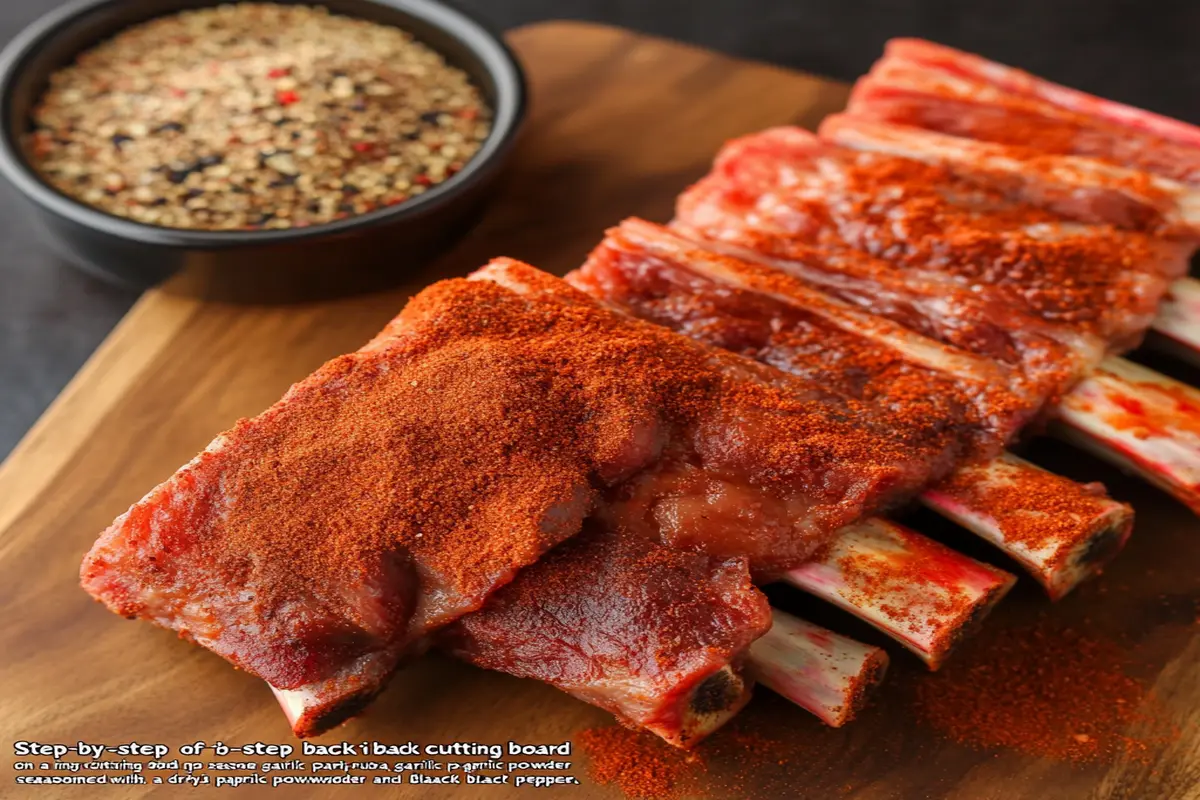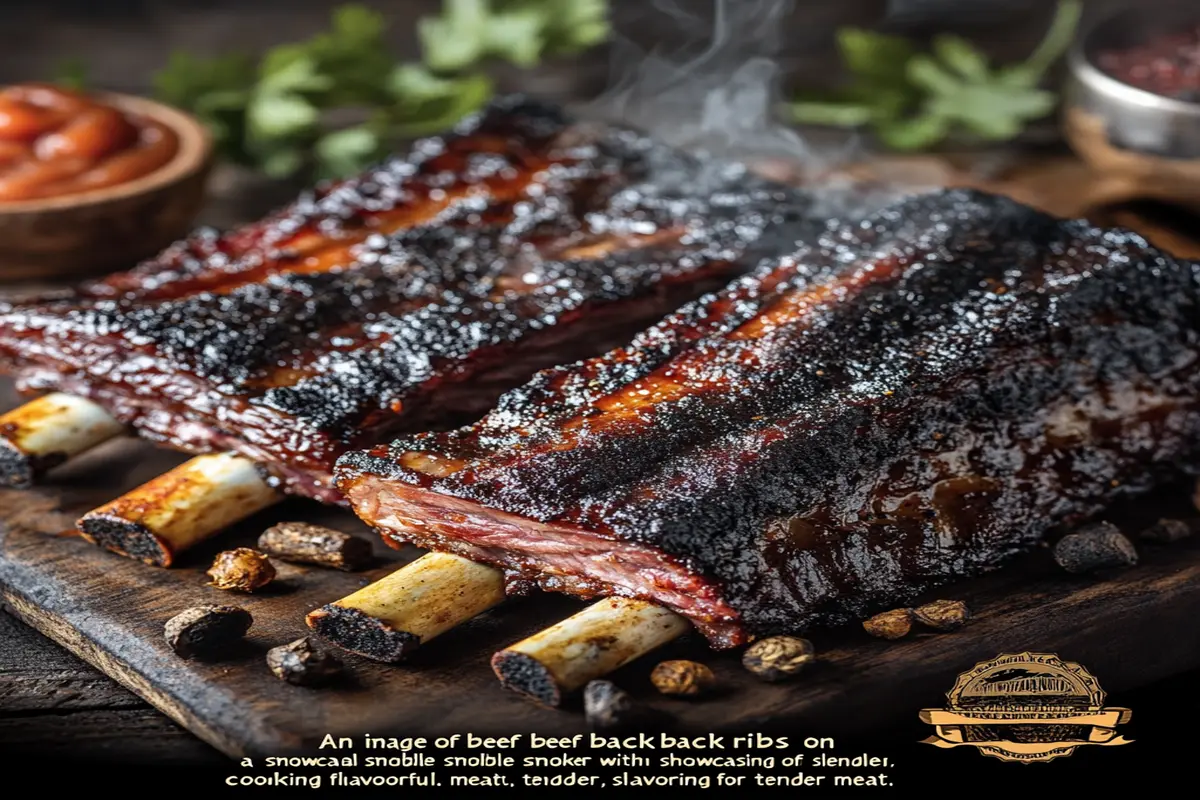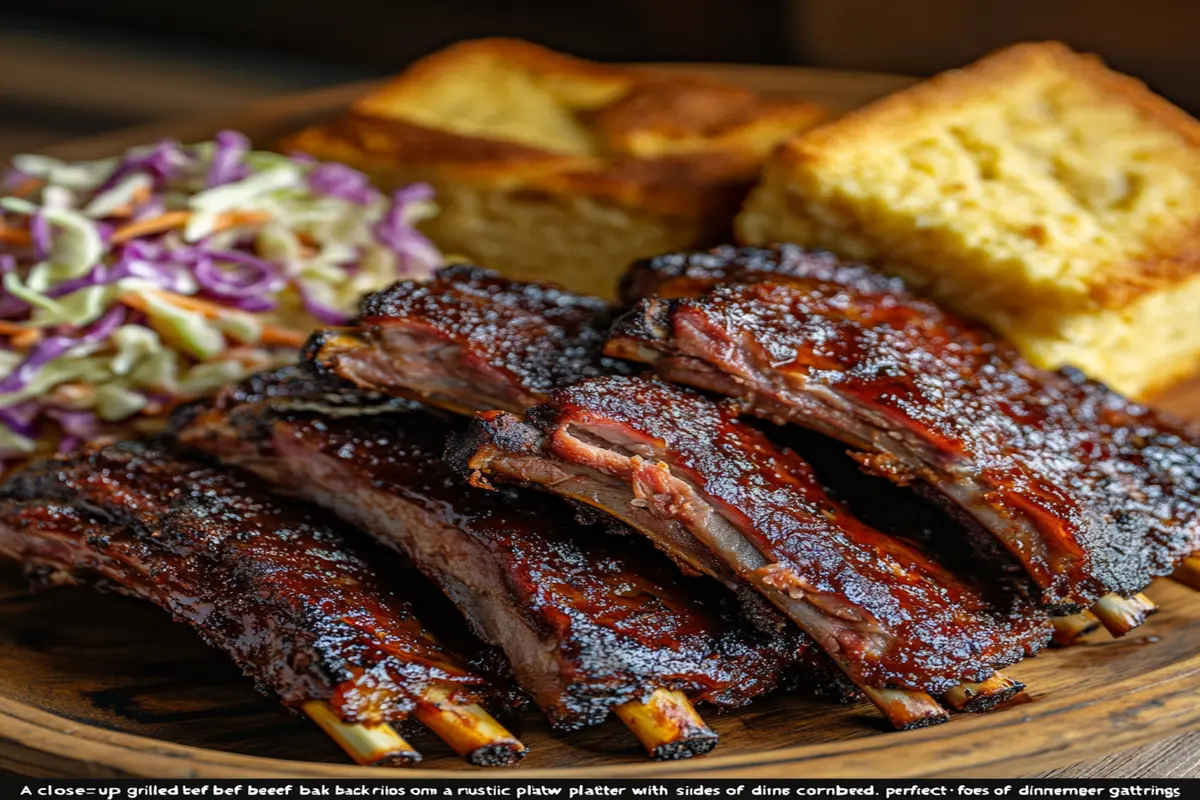When it comes to hearty and satisfying meals, few things can match the smoky, tender, and flavorful delight of beef back ribs. These ribs, with their rich marbling and bold taste, are a favorite among barbecue lovers and home cooks alike. In this guide, we’ll explore everything you need to know about preparing, cooking, and serving beef back ribs. From understanding what makes them unique to mastering cooking techniques and recipes, you’ll soon be serving up ribs that will impress even the toughest critics.
Understanding Beef Back Ribs
What Are Beef Back Ribs?
Beef back ribs are cut from the upper part of the cow’s rib section, near the backbone. Unlike short ribs, which are meatier, beef back ribs are known for their thinner layer of meat surrounding the bones. However, the meat they do have is exceptionally flavorful thanks to the marbling and proximity to the bone.
These ribs are often a byproduct of boneless ribeye or prime rib cuts, making them an affordable and delicious option for barbecue enthusiasts. They’re ideal for slow cooking or grilling, where their rich flavor can shine.
Nutritional Benefits of Beef Back Ribs
In addition to their incredible taste, beef back ribs also offer nutritional benefits. They’re a great source of protein, providing essential amino acids for muscle repair and growth. Additionally, they’re rich in zinc, iron, and B vitamins, which are crucial for energy production and immune support. Just remember, moderation is key since the marbled fat content can add up.
Beef Back Ribs vs. Other Rib Cuts
How do beef back ribs differ from other popular rib cuts? For starters, they’re leaner than beef short ribs but boast a similar rich, beefy flavor. Compared to pork ribs, they’re larger and have a more robust taste, making them ideal for those who prefer heartier meals. The cooking methods for beef back ribs often involve longer times at lower temperatures, which helps break down the connective tissue for tender results.
Best Cooking Methods for Beef Back Ribs
Grilling Beef Back Ribs
Grilling is a classic way to cook beef back ribs because it brings out their smoky flavor. Start by preheating your grill to medium heat and preparing a two-zone setup. Place the ribs on the cooler side of the grill to ensure they cook slowly and evenly. Baste them with barbecue sauce in the last 15 minutes for a sticky, caramelized finish. Grilled beef back ribs are perfect for outdoor gatherings or summer cookouts.
Slow-Cooking Beef Back Ribs for Tenderness
If you’re looking for a “set-it-and-forget-it” method, slow-cooking is your best bet. Place the beef back ribs in a slow cooker with your favorite marinade or sauce. Add onions, garlic, and a touch of broth to enhance the flavor. Cook on low for 6–8 hours until the meat becomes fall-off-the-bone tender. Slow-cooked ribs are a lifesaver when you want minimal effort but maximum flavor.
Oven-Baking: A Classic Approach
Oven-baking offers a reliable way to prepare beef back ribs. Wrap the ribs in foil and bake them at 300°F for 2–3 hours, ensuring they stay juicy. For an irresistible crust, remove the foil and broil them for a few minutes with your favorite sauce. This method is great for those who prefer cooking indoors, especially during colder months.
Smoked Beef Back Ribs for Ultimate Flavor
For an authentic barbecue experience, nothing beats smoked beef back ribs. Use a smoker or a grill with wood chips like hickory or mesquite for added depth. Maintain a low temperature (around 225°F) and smoke the ribs for 4–6 hours. The result? Ribs with a deep, smoky flavor and a tender bite. Smoked ribs are ideal for impressing your guests at any backyard party.
How to Season and Prepare Beef Back Ribs
Choosing the Right Marinade or Dry Rub
A great seasoning can make or break. Marinades add moisture and flavor, with options ranging from tangy barbecue to soy-based blends. Dry rubs, on the other hand, create a flavorful crust. Combine spices like paprika, garlic powder, cumin, and brown sugar for a classic rib rub. Either option works wonders, depending on your flavor preference.
Prepping Beef Back Ribs: Tips and Tricks
Before you start cooking, proper preparation is crucial. Always pat the ribs dry to help the seasoning stick better. Coat them evenly with your marinade or rub, and let them sit for at least 30 minutes to absorb the flavors. For even deeper seasoning, marinate the ribs overnight in the fridge.
Do You Need to Remove the Membrane?
One important step when preparing beef back ribs is removing the membrane on the bone side. This thin, silvery layer can become tough and chewy when cooked. Use a knife to loosen the membrane at one corner, then grab it with a paper towel and pull it off. Removing the membrane allows your seasoning to penetrate the meat and ensures a tender texture.
For additional rib recipes, you might find inspiration in The Ultimate Mac and Cheese Recipe to complement your meal.

Popular Beef Back Ribs Recipes
Barbecue Glazed Beef Back Ribs Recipe
Barbecue-glazed are a crowd-pleaser, perfect for any occasion. To make them, start by seasoning the ribs with a blend of salt, pepper, paprika, and garlic powder. Slow-cook the ribs in the oven or on a grill for about 2–3 hours at 300°F. In the last 15 minutes, slather them with your favorite barbecue sauce and broil or grill on high to caramelize the glaze. The result is sticky, smoky, and deliciously tender ribs.
Garlic Butter Beef Back Ribs
For a savory twist, try garlic butter beef back ribs. Begin by melting butter and sautéing minced garlic until fragrant. Brush the mixture generously over the ribs, then season with herbs like rosemary or thyme. Bake the ribs covered at 275°F for 3 hours. Finish by broiling them briefly for a crispy, golden crust. These ribs pair beautifully with mashed potatoes or steamed vegetables for a comforting meal.
Asian-Inspired Beef Back Ribs
Give your beef back ribs an international flair with this Asian-inspired recipe. Marinate the ribs in a mixture of soy sauce, hoisin, honey, ginger, and garlic for at least two hours. Roast them at 325°F for 2–3 hours, basting occasionally with the marinade. Serve with a garnish of sesame seeds and green onions for an elegant dish packed with flavor.
Classic Smoked Beef Back Ribs Recipe
Smoked beef back ribs are a must-try for barbecue lovers. Use a dry rub made of paprika, brown sugar, cayenne, and garlic powder to coat the ribs. Smoke them low and slow at 225°F for 4–6 hours, using hickory or applewood chips for extra depth. These ribs are perfect for outdoor gatherings, and their smoky aroma is sure to impress.

Tips for Perfect Beef Back Ribs Every Time
The 3-3-3 Rule for Ribs Explained
The 3-3-3 rule for ribs is a popular technique for achieving consistently tender ribs. The process involves smoking or slow-cooking the ribs for three hours, wrapping them in foil for another three hours to lock in moisture, and finishing them uncovered with a glaze or sauce for the final three hours. While this method is time-intensive, the results are worth it, producing ribs that practically melt in your mouth.
Common Mistakes to Avoid
Avoiding common mistakes can ensure your beef back ribs turn out perfectly every time. One common error is skipping the step of removing the membrane, which can lead to tough, chewy ribs. Another mistake is cooking at too high a temperature, which can dry out the meat. Lastly, be careful not to over-sauce the ribs too early in the cooking process, as this can lead to burnt, bitter flavors.
Best Tools for Cooking Ribs
Having the right tools makes cooking beef back ribs easier and more enjoyable. Essential items include a quality meat thermometer to monitor internal temperatures, a sturdy pair of tongs for flipping the ribs, and a basting brush for applying marinades or sauces. For smoking enthusiasts, a reliable smoker or a grill with a smoking box is indispensable.
For additional recipes that pair well with beef back ribs, consider visiting The Ultimate Beef Nachos Recipe, which offers bold flavors that complement the richness .
Frequently Asked Questions (FAQs)
Which of the Cooking Methods Is Best for Back Ribs?
The best cooking method for beef back ribs depends on your personal preference and available tools. Grilling is ideal for those who enjoy a smoky flavor with a bit of char, while slow-cooking or oven-baking ensures fall-off-the-bone tenderness. If you have a smoker, this method brings out the boldest flavors, thanks to the low-and-slow cooking process. Regardless of the method, the key to success is patience and proper preparation.
What Are Beef Back Ribs Good For?
Beef back ribs are incredibly versatile and can be used in a variety of meals. They are perfect for barbecue feasts, family dinners, or even casual gatherings with friends. Their rich flavor pairs well with side dishes like coleslaw, baked beans, or mashed potatoes. Moreover, the bones can be used to create flavorful broths or stocks, ensuring nothing goes to waste.
How Are Beef Ribs Supposed to Be Cooked?
Properly cookinginvolves slow, even heat to break down the connective tissues and render the fat. Always aim for an internal temperature of 200°F, as this ensures the meat is tender and juicy. Methods like smoking, baking, or slow-cooking allow the ribs to cook gently, preserving their flavor. Adding a final glaze or sauce enhances the ribs’ appearance and taste.
What Is the 3-3-3 Rule for Ribs?
The 3-3-3 rule for ribs is a popular technique for preparing tender and flavorful ribs. It involves three steps: cooking the ribs uncovered for three hours, wrapping them in foil with a liquid like apple juice for the next three hours, and finishing them with a sauce or glaze during the final three hours. This step-by-step process ensures the ribs remain moist while achieving a caramelized crust.
Conclusion: Why You Should Try Beef Back Ribs
The Versatility
Kielbasa and pasta recipes are perfect for more than just barbecue. Their versatility allows them to shine in various dishes, whether they’re smoked, baked, or grilled. Their bold flavor and tender texture make them a favorite for both casual meals and special occasions.
Encouragement to Experiment with Cooking Methods
Don’t hesitate to experiment when preparing . Try different cooking methods, marinades, or dry rubs to create your signature dish. Whether you’re using a smoker, grill, or oven, the possibilities are endless. With these tips and techniques, you’ll soon be serving ribs that rival any restaurant’s offerings.
The Culinary Benefits of Beef Back Ribs
What Are Beef Back Ribs Good For?
good for a variety of meals and occasions, making them a versatile choice for home cooks. First and foremost, they are perfect for barbecue feasts, offering a rich, smoky flavor that pairs well with classic sides like coleslaw, cornbread, or baked beans. Additionally, these ribs are excellent for creating hearty dishes like stews or casseroles when the meat is removed from the bones. For those who enjoy bone-in cuts, indulgent, flavorful option for dinner parties or weekend cookouts.
Beyond their use in meals, also ideal for making beef stock. The bones release a deep, savory essence when simmered, creating a base for soups or sauces. Moreover, the leftover meat can be shredded and used in tacos, sandwiches, or salads, ensuring nothing goes to waste.
Elevating Your Meal
To make your meal truly shine, ribs with the right seasonings and sides. For example, a tangy barbecue glaze enhances their natural flavor, while roasted vegetables or mashed potatoes add comforting elements. Don’t be afraid to experiment with spices like cumin, smoked paprika, or chili powder to create a dish that suits your taste.
Serving and Storing Beef Back Ribs
The Best Ways to Serve
When serving, presentation is key. Arrange the ribs on a platter and drizzle them with sauce for a polished look. Add fresh herbs or sliced citrus for an extra touch of color and flavor. Whether you’re serving them with cornbread and greens or a fresh salad, these ribs make a stunning centerpiece for any table. To complement their bold taste, consider pairing them with a zesty slaw or a creamy potato dish.
Storing Leftovers for Maximum Freshness
If you have leftover proper storage is essential to maintain their flavor and texture. Allow the ribs to cool to room temperature before transferring them to an airtight container. They can be refrigerated for up to three days or frozen for up to three months. To reheat, wrap the ribs in foil and warm them in the oven at 300°F to avoid drying them out.
For creative ideas to use leftover ribs, try shredding the meat and incorporating it into tacos, sandwiches, or pasta dishes. This way, you can enjoy your ribs in new and exciting ways long after the initial meal. gustoff

